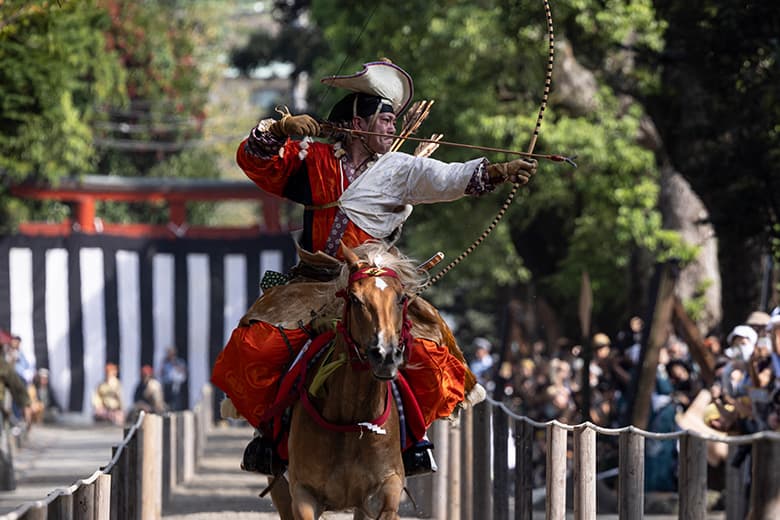If you’re a fan of horseback riding and Japanese culture, you’ve probably heard of yabusame—Japan’s traditional horseback archery. While you can watch it at various events across the country, finding an opportunity to try it yourself can be quite challenging. Luckily, working in the Japan travel industry I’ve come across a few high-quality experiences, which I’ll share below. But first, let me tell you more about yabusame and its place in modern Japan.
What Is Yabusame?
Yabusame is a form of Japanese horseback archery where riders shoot arrows at wooden targets while galloping on a straight track. It requires exceptional skill in both riding and archery, as riders must maintain their balance and accuracy at high speeds.
Japanese mounted archery is usually featured in festivals and Shinto rituals all across Japan. This is because yabusame has both a spiritual and cultural side; see more below.
The History of Japanese Horse Archery
This practice originated during Japan’s early history, with its roots tracing back to the 6th century. At that time, Emperor Kinmei introduced it as a ritual to pray for peace and agricultural prosperity. By the Heian period (794–1185), yabusame was a part of samurai training, serving both as a martial exercise and a ceremonial practice tied to Shinto beliefs.
By the Kamakura period (1185–1333), yabusame had become a highly formalized tradition, with prominent schools like the Ogasawara and Takeda styles emerging. These schools helped codify techniques and etiquette, preserving the practice as both a martial art and a ritual.

The popularity of yabusame fluctuated over the centuries. During the Edo period (1603–1868), it experienced a significant revival under shogun Tokugawa Yoshimune, who encouraged samurai to practice it as a way to uphold their discipline and traditions. However, with the introduction of firearms and the decline of mounted archery in warfare, yabusame gradually fell out of practical use.
Despite this, the tradition has continued to be passed down and is still actively performed across Japan, mainly becoming an attraction for both local and international audiences.
How Yabusame Is Performed Today
In modern yabusame events, archers dressed in traditional attire ride along a track about 218 meters long, shooting at three targets positioned at equal distances. The targets, typically made of wood, are placed at a height of around two meters.
Riders use specialized arrows called kaburaya, which produce a distinctive whistling sound as they fly. The performance is not just about hitting the targets, but also emphasizes form, timing, and maintaining balance on the horse. Riders often chant as they release their arrows, adding a dynamic and ceremonial element to the event.

Yabusame continues to thrive in modern Japan, primarily as part of festivals and ceremonies held at shrines like Tsurugaoka Hachimangu in Kamakura and Nikko Toshogu in Tochigi. While it has kept its historical and ritualistic elements, some groups have developed competitive versions, referred to as “sports yabusame,” making it more accessible to a wider audience.
Where to Book a Yabusame Experience in Japan
I’ve been working in the Japan travel industry since 2019, and in my experience, yabusame isn’t very popular with visitors. One reason is that you need to travel to the countryside to try it. Another is that, while not required, some horseback riding or archery experience can help you get the most out of it. That said, there are some fantastic experiences available in English, which I’ve listed below:
| Location | Price | Unique Features | Booking Link |
| Nikko, Tochigi Prefecture (2h30 from central Tokyo) | ¥66,000 /person | – 100% private (no mixed group) – Experience in English (interpreter included) – Suitable even for beginners – In Nikko, famous city for day trips or overnight stays – Participants get dressed traditional in training gear – Participants can choose to practice kyudo (Japanese archery, without horse) if preferred – Renowned instructor successor to to the Ogasawara School – Includes a private tour of the famed Nikko Toshogu Shrine – 180 minutes | Wabunka |
| Chikusei, Ibaraki Prefecture (2h from central Tokyo) | ¥49,544 /person | – Experience in English (interpreter included) – Suitable even for beginners – 150 minutes – Limited availability (not available during winter) | Rakuten Travel Experiences |
| Takeo, Saga Prefecture, Kyushu Island (South-West Japan) | ¥10,000 /person | – English supported but limited – Availability very limited (only a couple of days every few months) – 60 minutes | Activity Japan |
| Towada, Aomori Prefecture, Tohoku Region (North Japan) | ¥60,000 /person | – Three-day intensive course (2 to 4h/ day) – Designed for people who have horseback riding experience – Limited availability (once per month excluding winter) | Towada Horseback Riding Club |
*Please note that the prices quoted are as mentioned at the time of publishing. They may vary depending on when you book the experience.

Personally, I highly recommend Wabunka’s yabusame experience. Wabunka offers the most authentic Japanese cultural experiences available. All their activities are top-notch, held in fantastic venues, and led by exceptional instructors (which explains the higher price range compared to other booking platforms). Full disclosure: I know Wabunka personally, as I’ve worked with them through my role in the Japan travel industry. This is why I can confidently vouch for their professionalism and dedication to providing the best possible experiences for their customers.
The Bottom Line
Yabusame is one of these “only in Japan” experiences. I highly recommend it if you already have experience in horseback riding and/or archery. If you’re new to both, you’ll likely still enjoy yourself, but you might not be able to achieve much in the span of one lesson. In that case, you might want to explore other options for experiencing authentic Japanese culture. That said, yabusame experiences take you beyond the big cities and into the Japanese countryside, which is something I highly suggest including in your Japan itinerary.


Comments are closed.